OVERVIEW
By L.H.Barker
The Bladensburg painting links below
open a new window and are as follows:
Magruder
Dining Room (Politics and Port)
Magruder Dining Room (Politics and Port) full size/detail
Market
Master's House (Open for Business)
Market Master's House (Open for Business) full size/detail
Battle
of Bladensburg/War of 1812 (The Parole of an American Hero)
Battle of Bladensburg/War of 1812 (The Parole of an American Hero) full size/detail
The 3 paintings represent 17 months of
work & lot of research for the team, so I hope you enjoy & find them
educational.
Bladensburg is located in Prince George's county, MD and is approximately
ten miles east of Washington DC.
___________________________________________________________________________________________
The methodology:
Anatomy of a Painting/Illustration
Phase I: discuss the project scope, the time frame, budget, what needs to be covered, the audience, the goal of the piece, i.e. what are we trying to convey, to whom &, whose point of view or reference - determine what needs to be collected: research, maps, site reference photos, site plans, mediums that will be used for the actual painting
Phase II: establish the overall theme, begin adding details-generally work from the most important elements to minor ones -refine approach -for the characters, work out the actual poses, gestures & expressions; try to psyche out the characters minds, shoot mannequins/references as needed -work out composition issues
Phase III: prepare and scale the rough for transfer to the final artwork surface. This may involve printing out the rough at the final size and manually transferring it to illustration board with transfer paper or setting up a new digital master file that will evolve into the final master large format file. Gather & print, as necessary, reference materials that will be used during the final painting
Phase IV: begin the final process of painting the final artwork either manually or digitally
Phase V: document the artwork (photos, scans etc.), prepare image to be shipped or transferred, prepare shipping container
Phase VI: client
follow-up, project promotion, website update
___________________________________________________________________________________________
Project Backgrounds
The scrollable columns below are in chronological order & contain a lot
of material.
Each of the 3 historical illustrations took many
unexpected twists and turns while in progress. It always surprises people
to learn that working out the composition can take 50% or more of the paintings
total work time because of all the detail and accuracy required. You will
learn below why goauche is such a great medium for these projects due to the
time restraints (oils would take too long to dry) and the sometimes unavoidable
revisions in the paint stage.


| AN
ARCHAEOLOGIST'S VIEWPOINT |
| Project Team Leader Julie M. Schablitsky, Chief Archaeologist, Maryland State Highway Administration |
| Additional team members: Richard G. Ervin, senior archaeologist, MD State Highway Administration Nichole E. Sorensen-Mutchie, lab director, MD State Highway Administration; Archaeologist, MD Environmental Service Susan Langley, State Underwater Arch- aeologist, MD Historical Trust ************************************************** |
| Many thanks to the consulting experts who provided the team with valuable input and feedback: |
The Market Master's House ("Open for Business"): -Orlando Ridout V, Chief, Office of Research, Survey & Registration, Maryland Historic Trust -Kevin Crisman, Director, Center for Maritime Archaeology and Conservation, Texas A & M University -Nancy A. Pope, Historian and Curator of Postal History, National Postal Museum, Smithsonian Institution The Magruder House ("Politics and Port"): -Carter Lively, Executive Director, Hammond Harwood House The War of 1812/Battle of Bladensburg |
This project encompassed much more than just the period artwork. Below, I share with you some of the images from the archaeological digs at these sites and the educational outreach. All images below, courtesy Maryland State Highway Administration. More in depth information can be found at the Bladensburg blog link at the bottom of this column. |
Project Backgrounds in chronological order |
The Market Master's House, 1777 ("Open for Business"): |
 East face of the Market Master's house.  "It is really interesting to see which units are yielding the colonial artifacts and which are showing a strong prehistoric presence. Most of the colonial artifacts seem to be concentrated in units closest to and directly behind Market Master’s house. We have yet to find a privy, though, and it’s still a mystery to where that might be." 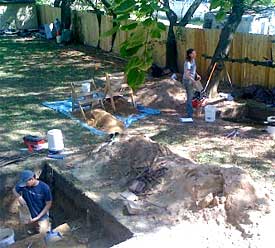 "Only two more days left to dig in the Market Master’s backyard. As expected, we may have the ephemeral remains of an outbuilding. In several of our units, we discovered dozens of badly decomposed nails and fasteners associated with the colonial stratum. Although it is a bit too early to make conclusions about our findings, it appears that when Christopher Lowndes built his stone house in 1760 he eventually added an outbuilding behind the house. The building does not appear to be residential since there are so few personal items."  "Archaeological activities are beginning to wind down at the Market Master's house. We spent a fairly mild summer day recording unit profiles and finishing excavations of the last few units." |
The Magruder House, 1787 ("Politics and Port") |
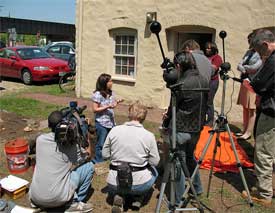 Lights, camera & action in front of the existing Magruder House  "Today (Tuesday March 25th) we continued excavations in the new units we started yesterday while Rick and Tom continued work on unit 1. Units 3, 4, and 5 were still inundated with water so we called in the big guns! The state highway’s administration brought us an industrial-sized water pump to allow us to transform units 3, 4, and 5 from bathtubs to workable, albeit very muddy, archaeological units."  "While excavating at the house, SHA archaeologists recovered a British 1774 King George halfpenny like the one pictured. For the public and the press, the coin was a palpable connection to the period of time just before the American Revolution and the subsequent tension that led up to the forgotten and fascinating event that made the town famous again, the Battle of Bladensburg. We cannot be certain where the coin came from, whether it was dropped by a wounded British soldier or was simply amongst the pocket change of Mr. Henderson, the occupant of the house at the time."  "Today Tara and I had some special helpers at the Maryland State Highway Administration archaeology lab. Marcell Thompson (left) and Javon Epps (right), Towson High School seniors, are participating in the Summer Youth Employment Program. They are interning with the Project Planning Division and get to experience different careers within SHA. They helped us wash artifacts from the Magruder House." |
The War of 1812/Battle of Bladensburg, 1814 ("The Parole of An American Hero"): |
| Excavation of the Indian Queen Tavern site turned our sights to the actual Battle of Bladensburg field, see that column on the right. |
 "Each test unit excavated today represented a different use of the site, from the earliest to the latest historic occupation. The only major concern is that we may have only scratched the surface of the Indian Queen Tavern period – where are all the pipestems and liquor bottles? With any luck, we’ll start turning them up in the next day or so!"  "Another activity that took place today included recording the stratigraphy of the site. The archeologists record the different layers of soil they see in the walls of the pit they have dug and this can help them determine the time period and activities of that layer." 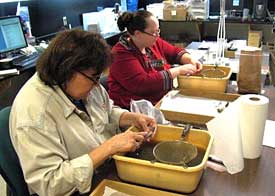 "In this full-speed-ahead, high-tech age of cyber-this and virtual-that, it’s reassuring to know that some things still require the human touch; that tools can be as simple as a Dr. Du-More’s toothbrush, a common kitchen sieve, a plastic pan of water, and a pair of willing hands. And even though yesterday’s four-hour stint left me with blanched hands and puckered fingers better suited to the corpse of someone tragically lost at sea, I’m ready to head back to the lab and give it another go next week." |
Miscellaneous & community outreach shots |
 "The Cultural Resources Section at the Maryland State Highway Administration (SHA) produces a quarterly newsletter. The summer edition of the Cultural Resources Bulletin (CRaB) is a special extended issue. It includes in-depth articles on the Bladensburg Archaeology Project, as well as information on other SHA projects." 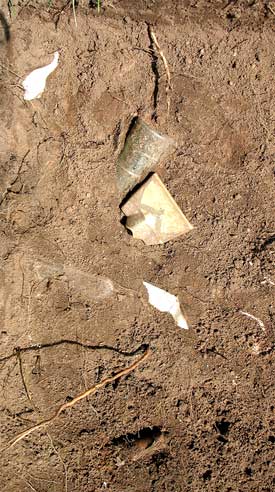 Artifacts being revealed in the layers of soil 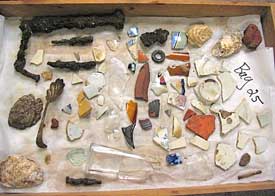 "Favorite finds? A serving spoon with shell-shaped bowl and rather elegantly bent handle; part of a plate from the Municipal Hospital (a psychiatric facility, I’m told); a small piece of scalloped, blue-edged ceramic; a few animal bones (Ah! Mortality); and an oddly shaped piece of corroded metal I still say looks like a miniature fertility goddess—I dub thee “Bladensburg Venus."  "A display of artifacts from the Magruder and Market Master’s House excavations were presented. At the Port Town’s day celebration children were given the opportunity to take part in a mock dig. Here are some photos from the events." |
About the Team |
| Julie M. Schablitsky directs the Cultural Re-sources Section at the Maryland State Highway Administration and serves as their Chief Archaeologist. Her recent research includes the War of 1812, 18th and 19th century domestic sites in Maryland, and John Paul Jones' Birthplace in Scotland. She also serves as a lead archaeologist on the PBS Series, Time Team America. |
Project Funding |
| The Bladensburg project was funded through the Transportation Enhancement Program and the Maryland State Highway Administration. |
 Visit http://bladenarch.blogspot.com/ Click here to open in a new window to read weekly accounts & comments of the archaeological events while in progress! 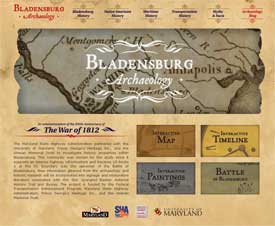 Visit http://www.bladensburgarchaeology.com/ Click here to open in a new window to see the Bladensburg archaeology interactive site. |
| ~END~ |
| AN
ARTIST'S VIEWPOINT |
| The War of 1812/Battle of Bladensburg "Embrace of the Enemies", 1814 ("The Parole of An American Hero"): |
October 20, 2010 The design & composition begin. Initially, this illustration began as a War of 1812 streetscape on Bladensburg's main thoroughfare or what is now Route 450/Annapolis Rd. With a gunshot wound to the thigh, Commodore Joshua Barney was to be seen carried on a stretcher down the main street in Bladensburg by British Capt. Wainwright and 3 other British sailors towards the field hospital (Ross Tavern) and passing in front of the George Washington House on August 24, 1814 @ 6 PM The client requested we explore the humanity, mutual respect and compassion between enemies noted in various written accounts rather than focus on battle carnage. The view and location of the piece were eventually moved west to near the Maryland/Washington border at the conclusion of the Battle of Bladensburg (adjacent to what is now the Fort Lincoln Cemetery) due to lack of supporting and necessary archaeological evidence after the team's archaeological digs. |
November 1, 2010 The scene and story shift to the battlefield: |
| ***************************************************** For an short description of the Battle of Bladensburg/War of 1812
check www.bladensburgarchaeology.com or www.wikipedia.org/wiki/Battle_of_Bladensburg ***************************************************** Setting: August
24, 1814, 3:45 PM, Bladensburg Rd to Washington at the county line. Barney was mounted between the two 18 pounders in the middle of the road when his horse was shot from under him. He then stood next to the canon when he was shot in the upper right thigh. The ball went in at an angle from his upper right thigh and into his hip area. He lost a lot of blood. Three of his men tried to help him leave the battlefield, but they only walked a few paces before Barney sunk down to the ground. Two of the three men left and attempted to escape. Lt. Jesse Huffington stayed behind with Barney to await capture by the British. Lt. Scott came upon Barney and supported him. He left Barney briefly and brought back Ross and Cockburn. "Well admiral, you have got hold of me at last," said the commodore. "Do not let us speak on that subject, commodore", Cockburn replied. I regret to see you in this state. I hope you are not seriously hurt." "Quite enough to prevent my giving you any trouble for some time," said Barney. Ross heavily praised Barney for his fighting. Ross and Cockburn spoke amongst themselves at which time they sent for their surgeon. After dressing Barney's wound, Cockburn paroled Barney allowing him to go to DC or Bladensburg. Wainwright was also there and was commanded to carry Barney down to Ross' tavern in Bladensburg. |
Client defines final key characters, their interaction & begins to put together the resources/research we will use. |
1. Captain Wainwright (first captain to Cockburn, British Royal Navy): (No known photo). He is dressed in a short round jacket, very young looking. In the scene, he will be looking down at Barney. |
2. Admiral George Cockburn (British Royal Navy): His body language communicates a bit of arrogance, but his face shows concern …. compassion does play on his lips as he tells Barney that he hopes he is not seriously hurt. |
 (Cropped) John James Halls portrait Rear-Admiral Sir George Cockburn, 1772-1853, (1776-1834) c. 1817. Courtesy National Maritime Museum, Greenwich, London. One of several portraits done in his life & used to study Cockburn's facial characteristics |
3. Lieutenant Colonel William Scott, British Royal Navy: (No known portrait) He is looking down at Barney's wound. |
4. General Robert Ross, British Royal Navy: On bended knee, he holds a canteen of water in his hand as if he has just offered Barney a drink (this is later changed) and he is looking at Barney's face |
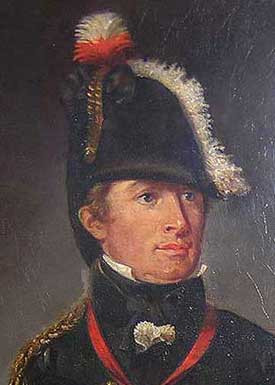 (Cropped) General Robert Ross portrait, Unknown artist. One of several portraits done in his life & used to study Ross' facial characteristics |
5. Commodore Joshua Barney (American US Navy): He will be pale from loss of blood and diaphoretic. His expression of one of discomfort, but not wincing pain and he is listening to Ross. He is 55 years of age. |
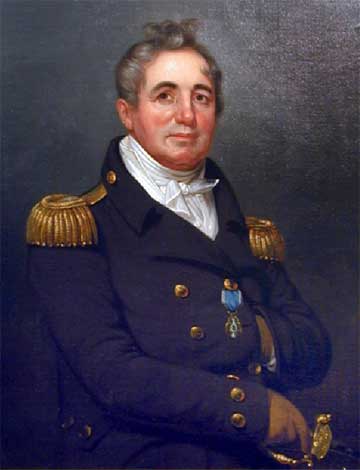 1819 Rembrandt Peale portrait of Joshua Barney commissioned by the city of Baltimore; one of several portraits done in his life used to study Barney's facial characteristics |
6. Lieutenant Jesse Huffington (Barney's aide & Sailing Master, US Chesapeake Flotilla): (No known portrait). He was 22 years of age. Body language and facial expression is that of protection and respect of his fallen commodore. Jesse is looking up and listening to Ross. ****************************************************** |
| Lining up & analyzing 300 years of historical maps in the Bladensburg area for the project's second Battle of Bladensburg view study: The topography of the area changed dramatically over the course of 300 years. Many geographical landmarks no longer exist to enable easy registering of maps. |
 Affair of Bladensburg, 1816 Map inset, Memoirs of My Own Times by General James Wilkinson shows the troop movement 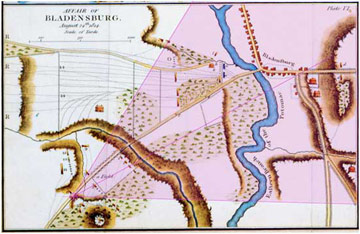 A 60-degree 'cone of vision' in pink over the Wilkinson Map studies a possible view looking NE down the hill towards the town of Bladensburg. 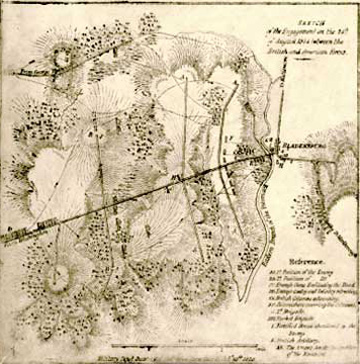 Roughly the same area as the Wilkinson map, above is a portion of an 1814 sketch by D. Evans, L't 3d Dr'ns D'y As't Q'r Mas'r Gen'l."Sketch of the march of the British Army under Gen'l Ross from the 19th to the 29th August 1814 : [central Maryland between Benedict and Washington D.C.]. Courtesy Library of Congress. The team is looking at different maps to splice together a composite of the action location & the topography in 1814. 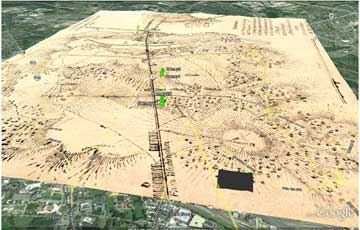 The 1814 D. Evans map superimposed in perspective on current terrain in Google Earth, looking NE  The 1814 D. Evans map superimposed in perspective on current terrain in Google Earth, looking NE up the hill towards Washington DC 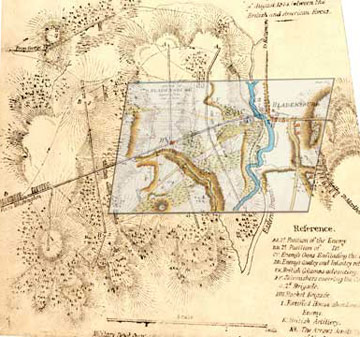 Trying to line up different maps with different scales: 1816 Wilkinson Map Insert over 1814 D Evans Map  Another map of the troop locations, Battle of Bladensburg: sketch of the action fought near Bladensberg [i.e. Bladensburg], August 24th, 1814/Thos. Ormsby, Weedon, July 19th 1816, Courtesy Library of Congress 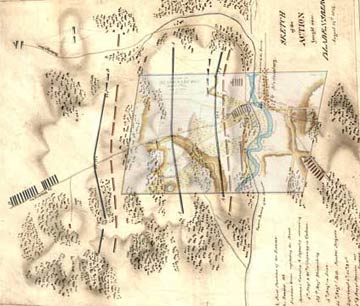 Continuing to line up different maps/different information: 1816 Wilkinson Map Insert over 1816 Ormsby Map  Section, 1886 USGS map; the Rives property mentioned in battle accounts still exists & is noted on this map 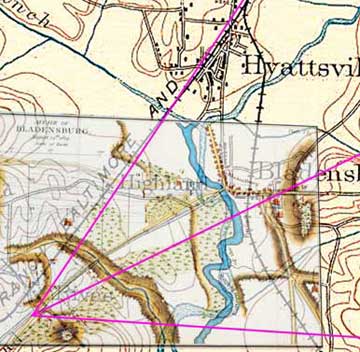 Wilkinson Map over 1886 USGS map with potential view (pink lines) 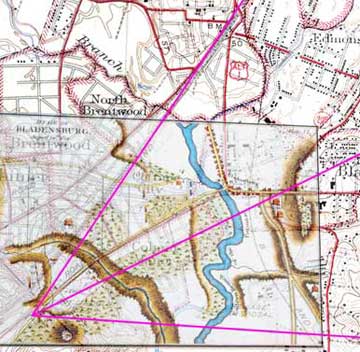 Wilkinson Map over 1946 USGS map with potential view 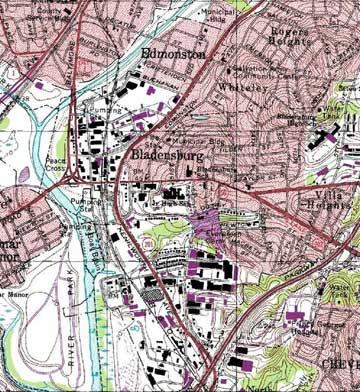 1979 USGS map in the vicinity of Bladensburg 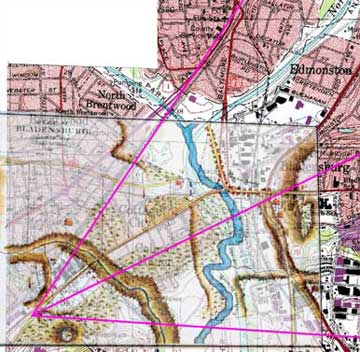 Wilkinson Map over 1979 USGS map with potential view 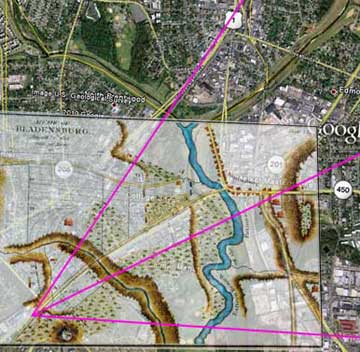 Wilkinson Map over 2010 USGS map with potential view in Google Earth ******************************************************** |
| Building the rough composition & study |
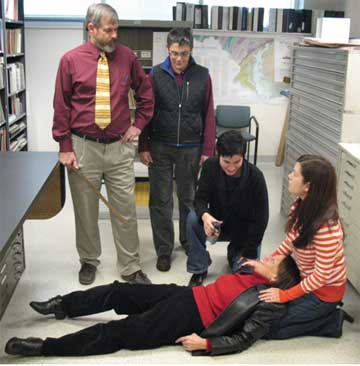 MD SHA team role-playing & doing mannequin work for main characters poses. Left to right back row: Richard Ervin, as George Cockburn; April Fehr, as William Scott; Lisa Kraus, as Robert Ross. Front: Anne Bruder as Joshua Barney and Julie Schablitsky (team leader), as Jesse Huffington. Nichole Sorensen-Mutchie, photographer. Courtesy MD SHA. |
Rough composition begins to be built digitally on my workstation. |
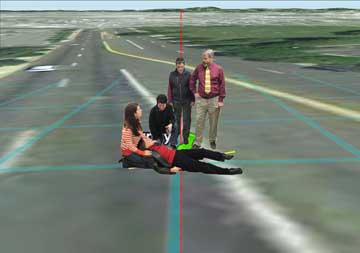 A mirror image of the SHA team's character positions super imposed on a real time Google Earth perspective view with a 10' grid overlaid. Looking down the hill NE towards the town of Bladensburg 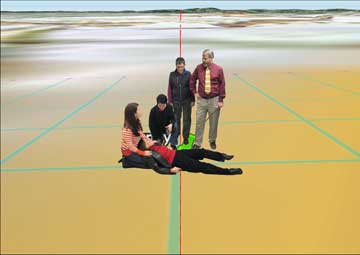 A mirror image of the SHA team's character positions super imposed on a 3-D version of the 1816 Wilkinson Map & a 10' grid for scale (overlaid in Google Earth) looking down the hill NE towards the town of Bladensburg 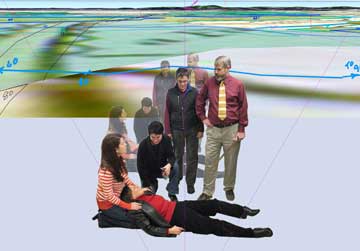 Google Earth perspective with many period topo corrections & the 1816 Wilkinson map 3-D overlay. Character positions (mirror image) super imposed (2 scale choices). 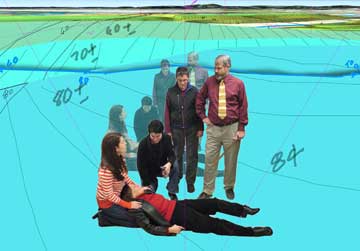 Modeling the new (1814) topo elevation zones to show the (Dueling) creek, Anacostia River & town of Bladensburg beyond. 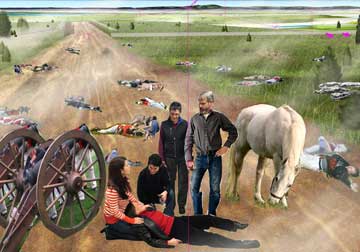 Dropping in additional props, figures (without regard to dress) & vegetation material in the rough composition 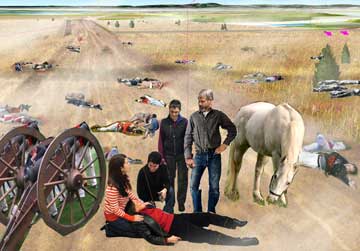 Changing the vegetation to reflect the dryness and extreme heat of August 24, 1814. There are written accounts of men collapsing & dying in the heat that day; it was reported it was in the low 90's that morning.  Experimenting with main character placement, gestures, props & proximity to the 18# cannons 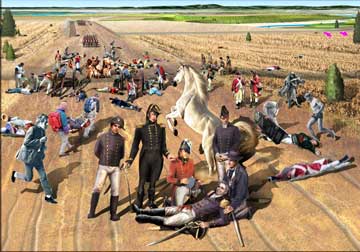 Working on peripheral figure placement & movement without regard to mannequin attire. The main characters get flipped back to their original positions. |
This rough composition development continued up until January 13, 2011, when the client made the decision to change the view & direction swinging roughly 100 degrees clockwise (looking SE) to the view above. ****************************************************** The rough process begins all over again with core characters thus far & Google Earth perspective shots of existing topography to establish the new direction & cone of vision (below). |
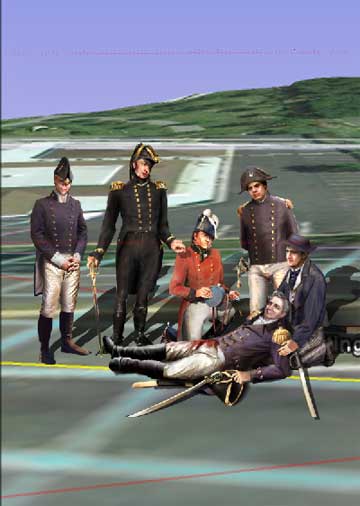 New view/direction, same physical location: this vertical format is changed to the horizontal one below 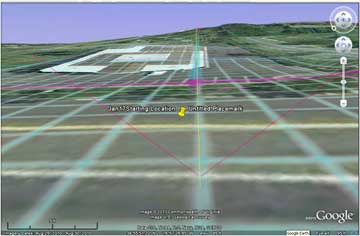 Developing this new view progresses 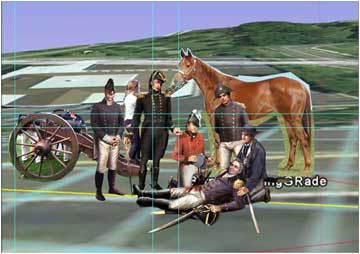 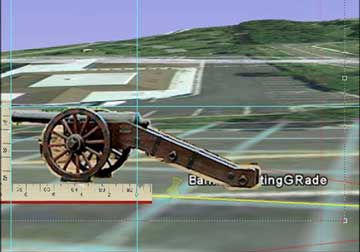 Always checking for correct scale: the foreground 18 pounder cannon 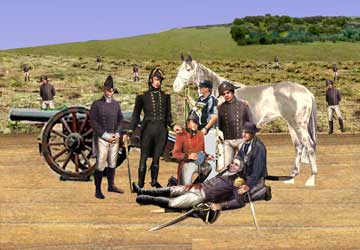 Adding textures for the 1814 landscape; adjusting contemporary topo contours to reflect 1814 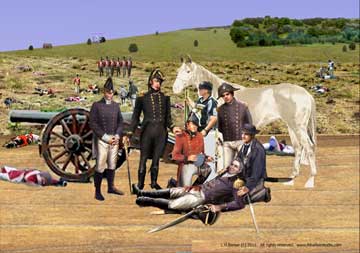 Placing British & American troop figures/killed, injured and alive for scale and location without regard to their dress 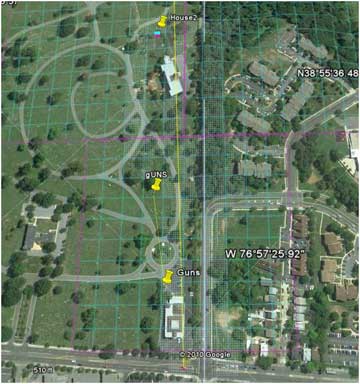 Locating exactly where Veitch's House/Hill and the 12# cannon line would fall today; Google Earth aerial with 100' grid overlay 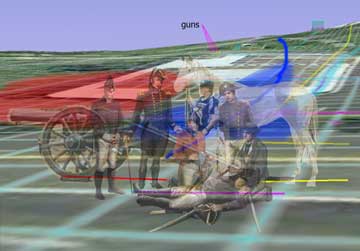 Establishing the American and British lines and their paths at the end of the Battle of Bladensburg (red-British; blue-American) 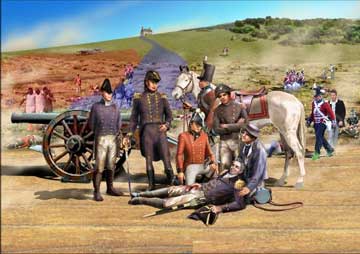 Tweaking those boundaries with client as more characters & props get developed; there is constant daily back and forth communication between team members 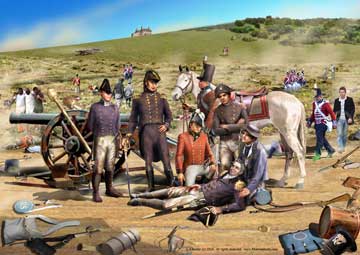 Working out rough ideas for the foreground and "road litter".  Discussing very specific clothing details back and forth 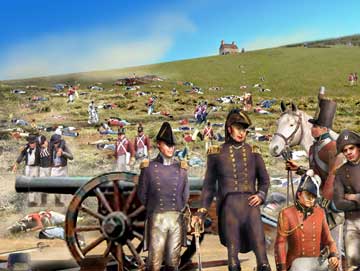 Adding soldiers to the mid and distant grounds, deciding who should be an American or British & doing an actual head count of the number of British & Americans on the hill. 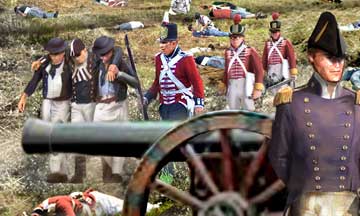 Details, details, details: adding a British guard behind wounded Americans 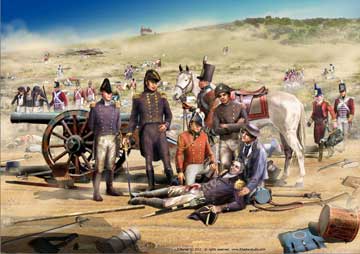 Working out the smoke/dust effects we want. Decision was made to leave it translucent rather than the heavy, opaque smoke & dust one normally sees in battle paintings, in order to show more battle aftermath detail |
| ~March 4, 2011~ The final Battle of Bladensburg rough composition is finally done. It has been almost 5 months of non-stop work & research for this piece to get to this point. Hand painting the gouache interpretive historical War of 1812 illustration begins! ************************************************** |
| The rough composition is printed out in pieces &
spliced to full size, 24"h x 34"w. A line drawing is transferred
via graphite paper as a painting guide and the painting process proceeds.
For a more complete methodology of this process, please see "An Artist's
Viewpoint", Magruder house on this page for rough composition transfer
details. The full size rough is hung on a nearby wall to act as a road
guide to the painting. The subject matter calls for a more brisk, raw
& active painting style than the Magruder and Market Master's house
paintings. |
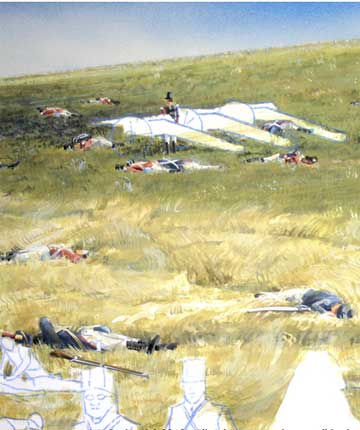 The sky and grounds & tree line are painted in first. Here 3 twelve # cannons in distant ground, scorched fields & pasture from the battle, fallen British & Americans-all in tiny accurate battle dress 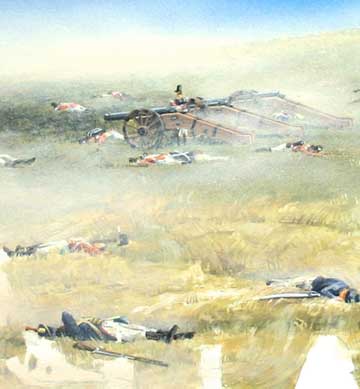 Same area but with the 12# cannons done & the residual smoke & dust from the battle added. The painting starts to become moody and atmospheric. As I work on each soldier, I wonder what they had been thinking when struck down, who their families were, what they felt about this war and who they left behind. It leaves me very emotionally drained at the end of each day. 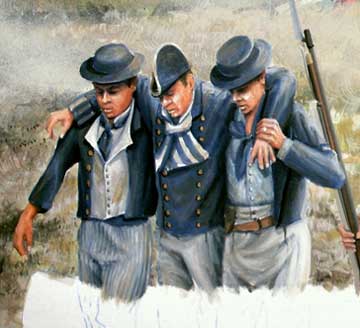 Detail of wounded Americans being escorted off the battle field. Showing the toil and emotions of each man, as well as the uniform details, takes time and care even for secondary figures. 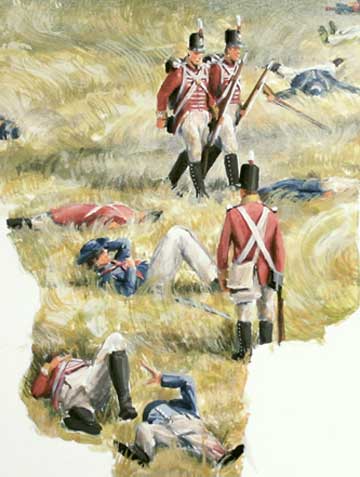 Soldier detail before final smoke & dust are painted in 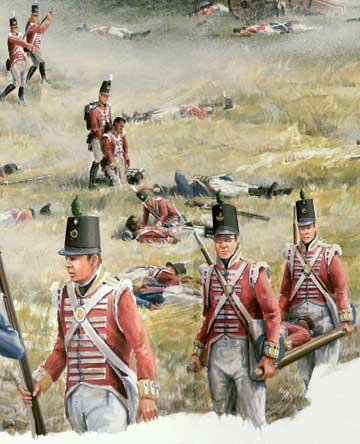   Close up of one of the field surgeons attending the wounded, final detail  Detail of the surgeon wearing a bloodied leather surgeon's apron rushing to assist Joshua Barney before final layers of smoke & dust are painted in 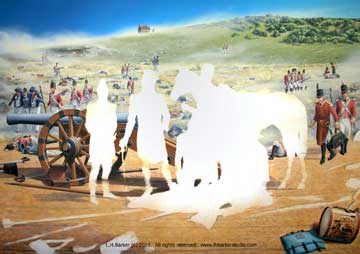 Most of the secondary material is finished & work turns to the key characters and foreground. The 18# foreground cannon will eventually have its wheel design changed. 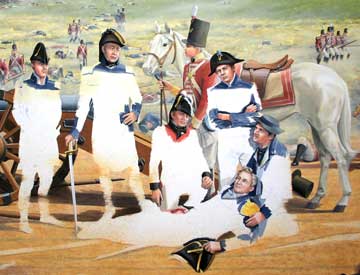 Painting begins on the main characters faces and hands after the horse and soldier behind them are finished. Every square inch of the painting gets checked for period authenticy, down to the horse's blanket & tack, saddle and hats strewn about the ground. 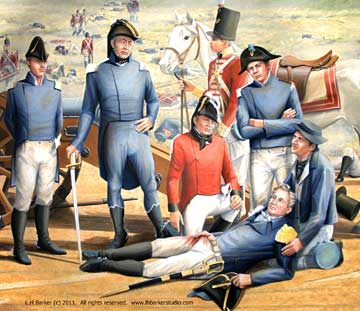 Uniforms start to take shape and details of the main characters 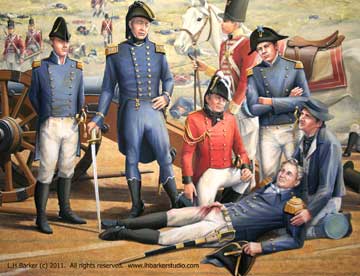 A lot more detail is added including suggesting tiny correct buttons/buttonholes, shako plates for each soldier and Joshua Barney's belt buckle. All the men's uniforms are dusty, dirty, sweaty and show wear.  Detail, Scott's torn and frayed uniform 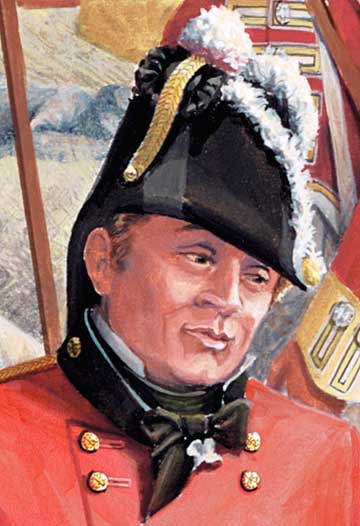 Finished British General Robert Ross 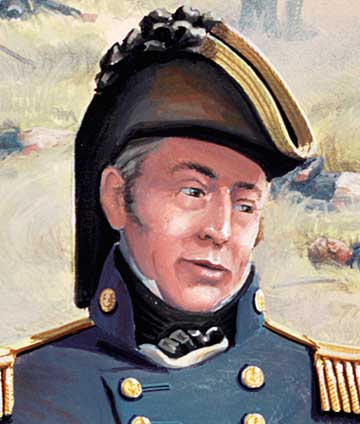 Detail: Finished British Admiral George Cockburn 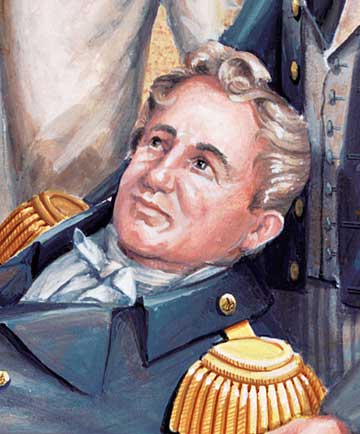 Detail: Finished American Commodore Joshua Barney 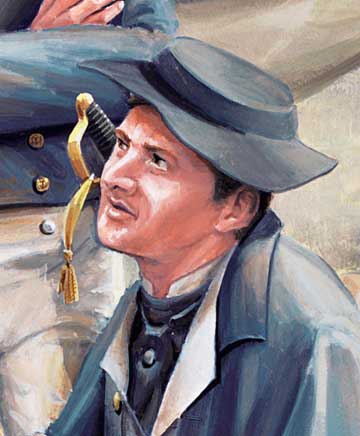 Detail: Finished American Sailing Master, Lieutenant Jesse Huffington, as we might imagine him (no known portrait) 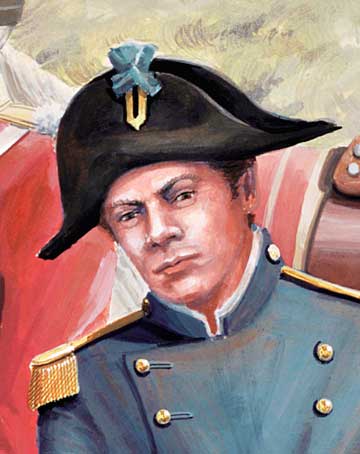 Detail: Finished British Captain Wainwright (first captain to Cockburn, British Royal Navy), as we might imagine him (no known portrait) 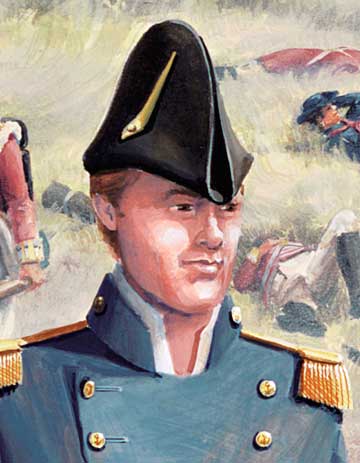 Detail: Finished Lieutenant Colonel William Scott, British Royal Navy, as we might imagine him (no known portrait)  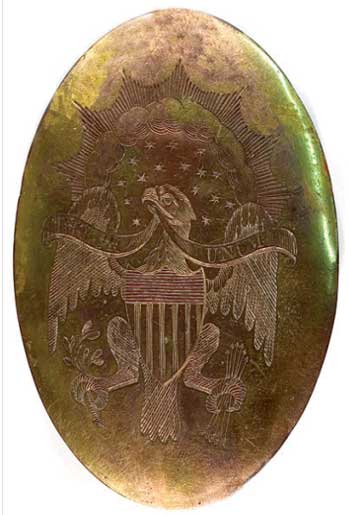 A surviving antique American shoulder medallion (held crossed straps in place at chest center) is used as a guide for the lost medallion left in the road sand in the foreground. There were hundreds of items researched during the project that were used as guides for authenticity.  The foreground cast aside or lost soldier items are finished  It is decided that the foreground 18# cannon wheel construction is too archaic for 1814, so the wheel has to be repainted with new strapping hardware & wood joints. 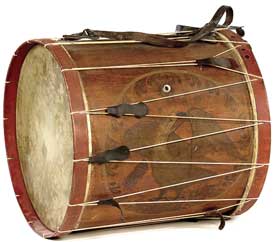 An antique militia bass battle drum that was used in the Battle of Bladensburg painting. Top: the actual drum (courtesy cowanauctions.com) , bottom: the painted drum without the 200 years of age, fading & wear. 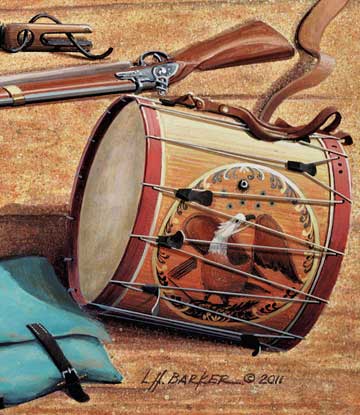 Signing, copyrighting and dating the painting. From the first Indian Queen Tavern concept to finished Battle of Bladensburg painting took the team 7 1/2 months to complete. 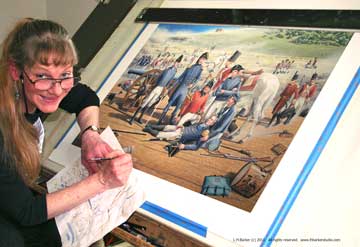 |
| A bit weary & wide-eyed after a marathon 17 months
of extremely long & intense work days working on the suite of 3 paintings,
a few quick promo shots are taken for my client. After the professional
scan & shipping are taken care of, the suite of the 3 Bladensburg
interpretive historical paintings project is done and under the care of
the Maryland State Highway Administration, Cultural Resources department. When the crate is opened and the painting inspected first hand, my client advises: |
| "Just unpacked it and we are all speechless....it is a beautiful piece..." |
| and the report from the unveiling/reception: |
| "It was a smashing hit. ...About 70 people there....standing room only. I gave the presentation on the archaeology of Bladensburg and then read a few paragraphs from Anthony Pitch's book that set the scene for the painting with the painting next to me covered. The tension was mounting and then the painting revealed. There was a pause and the room burst in applause. The audience, including Barney's descendents, all wanted prints from it. Rick gave background on the players and painting and people loved it. Looks like it was a home run Les. You out did yourself. " |
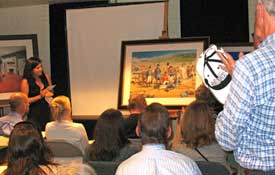 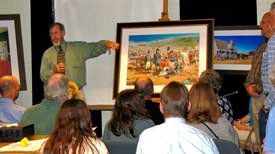 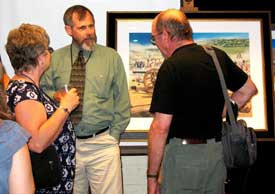 June 15, 2011: team members Julie Schablitsky (top image, standing left in the lovely black dress), Richard Ervin (middle and bottom in the olive shirt and Nichole Sorensen-Mutchie (the photographer and out of the images) host the unveiling of "Embrace of the Enemies" and field questions about the project and their research. Courtesy Maryland State Highway Administration. -copy-3.jpg) |
| Special thanks to Lisa Zeimer, AICP, Assistant Vice President, Parsons Brinckerhoff, Environment Manager and Henry Ward, Parsons Brinckerhoff for their help managing the contract paperwork while I tried to focus on the artwork. |
| ****************************************************** |
| Please stop by again & visit my other fascinating
suites of historical paintings: Historical projects index and Overall portfolio index Thank you for your interest! Les Barker/L.H.Barker |
| ~END~ |

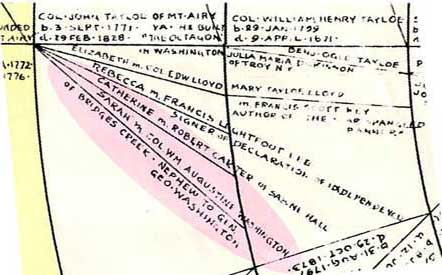
| 331
Ridge Rd, Queensbury, NY 12804 Phone: (518) 792-0879 Website (c) L.H.Barker 2004-2015. All rights reserved. |
Interpretive architectural and historical
|
| Architectural Illustration ; www.lhbarkerstudio.com Related search terms: Bladensburg Archaeological Project, Magruder house, Market Master's House, War of 1812, Indian Queen Tavern, Port Of Bladensburg, Julie Schablitsky, Maryland State Highway Administration, Battle of Bladensburg, archaeological paintings, antiquity illustrations, technical imagery, hand painted architectural illustrations, architectural perspective, rendering, perspectivist, historical visualization, Bladensburg historical district |
| Website (c) L.H.Barker 2004-2015. All rights reserved. |